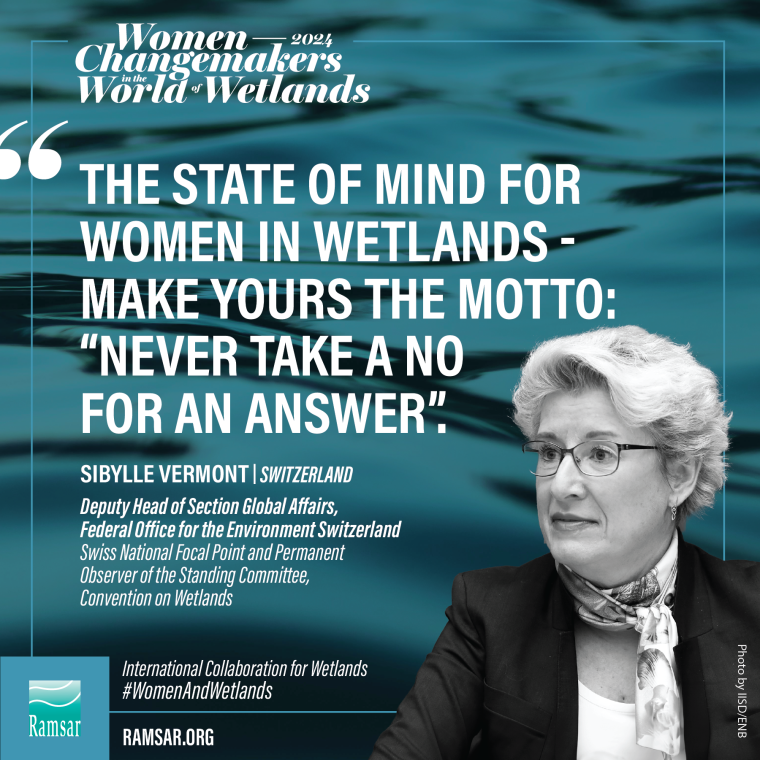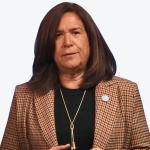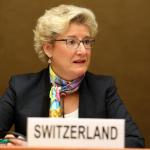
Sibylle Vermont
Deputy Head of Section Global Affairs, Federal Office for the Environment Switzerland
Biography
Sibylle Vermont was born in Switzerland, where she spent her formative years honing her linguistic skills in French, English, German, Italian, and Spanish. Her journey into the realm of environmental stewardship began with her academic pursuits.
She obtained her Honour's degree in Natural Sciences, majoring in Botany and Zoology, from Lausanne University, Switzerland. Driven by a passion for understanding ecosystems, she pursued her Master of Science at the University of Witwatersrand in Johannesburg, South Africa. Her thesis delved into the intricate interplay between cattle and impala defoliation patterns on savanna grasses, showcasing her early commitment to environmental research.
Sibylle's academic journey culminated in a Diploma in Environmental Management from the Institute of Public Administration at Lausanne University (IDHEAP), where she further honed her expertise in environmental policy and administration.
Since 1991, Sibylle has been a stalwart at the Federal Office for the Environment, assuming the role of Deputy Head of Section for Global Affairs within the International Affairs Division. Her responsibilities encompass a broad spectrum of environmental policy and institutional matters at both global and regional levels.
Sibylle's influence extends across various domains, including wetlands conservation through her involvement with the Convention on Wetlands, water resource management via her contributions to the Convention on the Protection and Use of Transboundary Watercourses and International Lakes (Water Convention), and forest conservation initiatives such as the United Nations Forum on Forests. Her leadership roles within international environmental bodies, such as chairing the Task Force on Water and Climate of the Water Convention, underscore her commitment to effecting positive change on a global scale.
Beyond her official duties, Sibylle remains actively engaged in private initiatives, notably contributing to the UNESCO World Heritage Site of the Cradle of Humankind in South Africa.
Sibylle Vermont's career stands as a testament to her unwavering dedication to environmental conservation and her tireless efforts to foster international cooperation in safeguarding our planet for future generations.

Questions and Answers
What personal experience has shaped or inspired your journey?
Living most of my life on the shores of Lake Geneva and Neuchâtel - My favourite leisure pass time was nature walks along the marshlands and shores, paddling, sailing, and swimming. For a Swiss citizen, not many mountains were involved!
As a child, I spent hours in my grandmother's garden observing nature, and collecting my first love, small garden striped and yellow snails… which I released in her house. Later my focus turned to observing butterflies and other insects such as dragonflies. Following my first trip to Africa as a teenager, my interests expanded to include bigger African wildlife such as chameleons and antelopes.
Studying botany and zoology got me closer to wetlands, specifically while doing my Master’s degree in savanna ecology at Nylsvley Nature Reserve in South Africa, which is close to one of the richest wetlands for bird diversity.
Upon joining the Swiss Federal Office for the Environment I was handed the file on water management and the Convention on the Protection and Use of Transboundary Watercourses and International Lakes.
A turning point came in 2002 when I discovered the Convention on Wetlands just before COP 8 in Valencia (as a dual water and biodiversity Convention). I was invited to be part of the Swiss delegation to COP 8 and I became the Swiss focal point which allowed me to demonstrate the importance of ecosystems for the protection of water resources.
Who is the influential figure who has inspired your actions, and what specifically about them has been motivating?
Three men!
My late friend Philip Tetley in South Africa for our inspired discussions as future zoologists, realizing we did not get the full picture without botany to understand the ecosystems following readings of Odum on ecology.
Mr Philippe Roch, the former State Secretary and Director of the Federal Office for the Environment of Switzerland gave me the freedom to innovate at the second World Water Forum in 2000 in the Hague on linking ecosystems to IWRM (para 1. Water resources, and the related ecosystems that provide and sustain them, are under threat from pollution, unsustainable use, land-use changes, climate change, and many other forces; para. 5: …IWRM …integrates surface water, groundwater, and the ecosystems through which they flow).
At the 3rd World Water Forum in 2003, tasking me with his personal sentence for the Ministerial declaration (para. 24: To ensure a sustainable water supply of good quality, we should protect and use sustainably the ecosystems that naturally capture, filter, store, and release water, such as rivers, wetlands, forests, and soils). This started a whole new era in the next major water meetings - less focus on pipes and taps and much more on the importance of ecosystems - wetlands and forests- to water resources.
Mr Denis Landenbergue, formerly with the WWF Water programme, is one of the champions in supporting African countries to designate Ramsar Sites for the Convention on Wetlands. I consider him my everlasting godfather for the Convention On Wetlands. He introduced me to all the main actors at my first COP (COP 8 in Valencia in 2003) and shared with me foundational knowledge about the functions of wetlands and water.
In your conservation efforts for wetlands, what key challenges did you face and how has this experience fuelled your dedication to making a positive impact?
On the meaning of words: The key challenge is about what is the Convention on Wetlands. Too many believe wetlands are limited to marshland and peatlands, but very few understand wetlands encompass much more, i.e. lakes and rivers, underground aquifers, swamps and marshes, wet grasslands, peatlands, oases, estuaries, deltas and tidal flats, mangroves and other coastal areas, coral reefs, and all human-made sites such as fish ponds, rice paddies, reservoirs and salt pans.
Duality: The Convention on Wetlands is not just for biodiversity or waterbirds (from the old title) but about the whole fauna and flora of such ecosystems. Therefore not just about water-related bodies but also all living creatures living in or around them. This realization triggered my efforts to demonstrate the duality of the Convention, which has the rare capacity to bring together biodiversity and water experts for an ecosystem approach now rebaptized… nature-based solutions.
Furthermore, during my work on forests and involvement with the Convention on the Protection and Use of Transboundary Watercourses and International Lakes, I connected all 3 topics every step of my work. One example can be found in the UN Recommendations on payments for ecosystem services in integrated water resources management (2008).
The UN Strategic Plan for Forests also mentions the Convention on Wetlands as many decisions/resolutions of the UN organizations due to the Swiss proposals.
Since 2004, the work programmes of the Convention on the Protection and Use of Transboundary Watercourses and International Lakes have all referenced ecosystems and engaged with the Convention on Wetlands.
All women in this category: International Collaboration

Elise Allély-Fermé
Director of Conservation Pronatura México.
More information
Lili SUN
Founder and Deputy Board Chairwoman, Mangrove Conservation Foundation
More information
Lina Pohl
Representative, Food and Agriculture Organization of the United Nations in Mexico.
More information